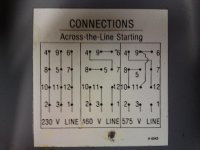briancr
Member
This is aimed at the American members. I have a 12 wire motor wired for 230V. The supply to the VFD is 230V three phase. Our standard supply here is 380V three phase. I would like to standadise my drives, we only use 380v three phase drives. My question is, can I wire my motors to run on 380V three phase? See the attached picture of motor connections







